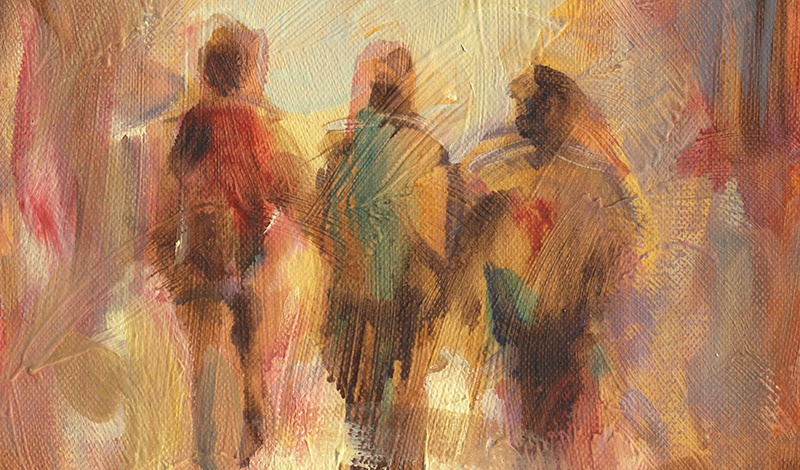This series highlights how Buddhism can enhance daily living. As Nichiren Daishonin says: “When the skies are clear, the ground is illuminated. Similarly, when one knows the Lotus Sutra, one understands the meaning of all worldly affairs.” [1]
Did you know that simply walking with someone can strengthen your relationship with them?
Research shows that “social walking” helps us understand others. Neurologist Shane O’Mara noted that human beings mirror others’ movements and brain activation patterns.[2]
Walking together, we instinctively synchronize our steps and maybe even the movement of our arms and legs, breathing or heart rate. It can elicit our brain’s “social cognition,” how we observe, process, store and use information—like gestures, expressions or other social cues—to predict the other person’s trajectory. This synchronization can form a basis for good relationships.[3]
Walking with someone stimulates shared attention, causing us to look and move forward in the same direction, creating a shared experience of progressing toward a common goal.
Psychologist David Krauss writes: “Synchronous movements seem to prompt greater experience of self-other overlap. Self-other overlap is associated with more compassion and concern for others, more helping behaviors and resource sharing.”[4] Activities like walking, dancing, playing music or exercising in step with others helps us better connect with those around us.
In the SGI, we emphasize the importance of “running” or taking action with fellow Buddhists as we talk, visit, chant and study with others. The synchronicity of moving together toward our shared goal of widely spreading Nichiren Buddhism’s tenets of respect, equality and peace—what we call kosen-rufu—helps us develop compassion and strengthen our ties.
Walking the Path of the Oneness of Mentor and Disciple
Our great mentors in faith—Nichiren Daishonin and the three founding Soka Gakkai presidents—have exemplified how to ground oneself in Buddhist practice to overcome various trials and win. We, too, can develop the same winning life state by living with the same spirit and vision.
In the turmoil after World War II, Ikeda Sensei attended his first Buddhist meeting in August 1947, where he met Josei Toda.
Disillusioned and feeling betrayed by political and intellectual leaders who had quickly changed their tune from advocating war to advocating peace, Sensei sought something or someone he could rely on.
Meeting Mr. Toda and learning of his imprisonment for refusing to support Japan’s war efforts and discard his religious beliefs, Sensei sensed his great conviction and felt he could trust him. He chose him as his mentor and worked with him to spread Nichiren Buddhism and awaken as many people as possible to their inherent dignity and unlimited potential. Sensei writes:
Striving alongside Josei Toda, I have advanced straight ahead on the path of kosen-rufu. It is the path of human revolution, the path of victory in life. It is the path for realizing happiness for all people, for transforming the karma of humankind and for creating a future of world peace. It is also the great path of the oneness of mentor and disciple throughout the three existences of past, present and future.[5]
Moving the Trajectory of Humanity Toward Peace
Many SGI members have traveled the same path as their mentor despite not being in close physical proximity to him. We can learn through Sensei’s many writings, like The Human Revolution and The New Human Revolution, how to unite with his heart and take action.
The May 14, 2021, issue of the World Tribune highlights an SGI-USA member’s experience illustrating this point. Nanami Vittor suffered the loss of two older sisters in World War II, and her family endured financial devastation due to the war. Why do countries go to war? Why do people kill one another? she wondered.
At 19, she found the Soka Gakkai, a peace movement focused on each person’s happiness. She was struck by the first sentence in Sensei’s novel The Human Revolution: “Nothing is more barbarous than war” (p. 3). Encouraged by his guidance to “simply become the best daughter,” she understood peace begins with one’s family. Despite her family’s initial opposition to her Buddhist practice, her care for them led her parents and many others in her family to practice alongside her. She also has shared the Buddhist philosophy of peace in the more than 20 countries she has visited.[6]
Walking together with our mentor and fellow members to visit and nurture others in faith allows us to cultivate the positive relationships that will move the trajectory of humanity toward lasting peace.
—Prepared by the SGI-USA Study Department
October 20, 2023, World Tribune, p. 9
References
- “The Object of Devotion for Observing the Mind,” The Writings of Nichiren Daishonin, vol. 1, p. 376. ↩︎
- Shane O’Mara, In Praise of Walking: A New Scientific Exploration (New York: W.W. Norton Company, 2021), p. 169. ↩︎
- https://www.psychologytoday.com/us/blog/atypical-children-extraordinary-parenting/202005/walking-together-may-resolve-conflicts-during <accessed Oct. 12, 2023>. ↩︎
- Ibid. ↩︎
- June 2015 Living Buddhism, p. 29. ↩︎
- May 14, 2021, World Tribune, p. 5. ↩︎
You are reading {{ meterCount }} of {{ meterMax }} free premium articles

